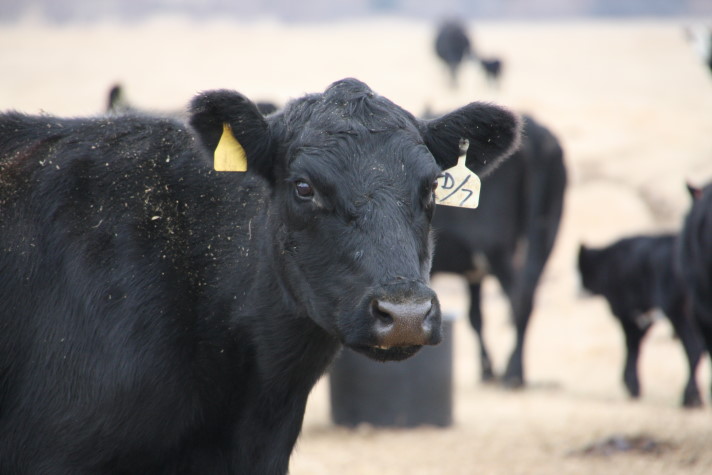
Agricultural News
Malnutrition Could Claim Many Cows This Winter, Sparks Says
Tue, 04 Dec 2012 11:17:10 CST

With many cow-calf operations hanging by a thread this winter due to high feed and forage costs and dwindling water supplies, Dave Sparks, DVM, Oklahoma State University Extension Area Veterinarian, offers some advice for making the best of it in the latest Cow-Calf Newsletter.
I hear it every day. All across Oklahoma ranchers are looking at short winter pastures, scarce and expensive hay, and high supplement costs. The temptation is to hope that the cows can make it through the winter and then everything will be better next year. Unfortunately for some producers who fail to meet the nutritional demands, there will not be a next year. Years ago I had a mentor that reminded me often, "You just can't starve a profit out of them." In times of scarce forage, toxicity problems are intensified. Lots of corn stalks and other crop residues have been baled this year. One of the big problems in baled crop residues is accumulated nitrates. It can also be a problem in the big-stemmed tall cultivated grasses. We don't normally associate nitrate toxicity problems with Bermuda or prairie hay, but it can occur in drought years, especially if the hay was baled late and has a significant amount of pig weed or curly dock. These plants are nitrate accumulators and in dry times their growth can outrun the growth of the grass. Nitrates can cause death of the cattle consuming the hay, but they cause abortion in cows at an even lower level. If the nitrate levels are high, it can't be used for livestock unless it is ground thoroughly and diluted with other feeds. If the nitrate levels are suspect, the hay may be used by feeding it to non-pregnant yearlings. Bova Pro® boluses can help cattle compensate for moderate nitrate levels. If there is any doubt, especially with crop residues, sorghums, sudan, johnsongrass, or weedy hay, have the hay tested for nitrates. The few dollars you spend can save a disaster.
As ponds and creeks get lower, the water not only gets foul but also minerals and toxins become more concentrated. Sulfur amounts that may not be a problem in a pond at normal level can easily exceed toxic levels in low ponds and result in poor performance or death. Bluegreen algae is a problem that causes sudden death and is usually found in pond water in the summer. This year, however, the OSU Diagnostic Lab is still finding bluegreen algae in water samples submitted. Old or thin cows may expire in the mud trying to get to drinkable water. This will likely be more and more of a problem as the winter progresses. Perhaps the biggest and most widespread water problem producers face is decreased consumption. As ruminants, cattle not only require water for metabolic functions but also for digestive functions. Many ponds still have water, and the cows are drinking it, but it is so foul tasting and smelly that they only drink minimal amounts. The rumen can't work properly if it isn't full of water. If you are not providing clean water in sufficient quantities for cows to consume adequate amounts, you may be wasting the high priced supplemental feed you are paying for.
The trend towards feeding round bales has saved a lot of labor but it can also bring on other problems. Always retrieve and destroy twine and netting. Every winter many cows die from ingesting these plastic items which then cause intestinal blockage. Be sure to spread the hay far enough, or use sufficient hay feeders to insure that the weak, old, or timid cows get their share.
Malnutrition will claim the lives of many cows this winter, and it may eliminate the production of many more. Available nutrients are utilized in a predictable priority. The first priority is body maintenance such as circulatory and respiratory functions and maintaining body temperature. The second priority is lactation. Only when these priorities are met and more nutrients are available can the cow meet her reproductive requirement and become pregnant. Simply put, cows in poor body condition simply can't breed back efficiently. As the winter progresses adverse weather increases the maintenance requirement and the problem worsens. You may marginally make it through the winter with thin cows that just can't breed back. That winter feed bill looks awfully expensive if there is no paycheck next year to cover it.
Now is the time to take a realistic look at your winter program. If you haven't already pregnancy checked your cows, you should do it now. Before we get farther into the feeding period would be a great time to eliminate the expenses involved in wintering open cows, old cows, poor mothers, poor producers, and cows with too much "attitude." The salvage value of these cows may help you purchase enough feed to arrive in the spring with your best cows in good shape and ready to breed back while doing a better job of milking for the calves they have by their side. If you decide to save replacement heifers when it rains again you will be saving these replacements from your most profitable cows. Your Oklahoma State University County Extension Educator can help you with the feed, forage, and water testing you may need as well as helping you to find a least-cost program that will meet the requirements of your cows.
WebReadyTM Powered by WireReady® NSI
Top Agricultural News
More Headlines...



















